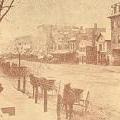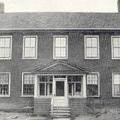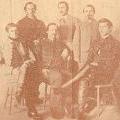 The St. Albans Raid of October 19, 1864 is one of the most celebrated incidents in Border lore. Considered the northernmost engagement of the American Civil War, it involved about twenty Confederate soldiers who, under the command of a young lieutenant, Bennett Young, carried out a successful raid on three banks in St. Albans, Vermont. The raid, launched from Canadian soil (Missisquoi County), took the sleepy town of St. Albans completely by surprise, and caused an international furor which threatened to bring Britain into the war on the side of the Confederacy. It also demonstrated to authorities in both countries how vulnerable the border was.
The St. Albans Raid of October 19, 1864 is one of the most celebrated incidents in Border lore. Considered the northernmost engagement of the American Civil War, it involved about twenty Confederate soldiers who, under the command of a young lieutenant, Bennett Young, carried out a successful raid on three banks in St. Albans, Vermont. The raid, launched from Canadian soil (Missisquoi County), took the sleepy town of St. Albans completely by surprise, and caused an international furor which threatened to bring Britain into the war on the side of the Confederacy. It also demonstrated to authorities in both countries how vulnerable the border was.
FUNDS FOR THE CONFEDERACY
The aim of the St. Albans Raid was to secure badly needed funds for the struggling Confederacy, and, if possible, to divert Union troops away from service in the South. The idea was to seize as much money as possible and set fire to the town. While the first goal was achieved (the raiders made off with $208,000); the second was not (they only managed to set fire to one shed).
Leading up to the raid, Confederate soldiers in disguise arrived in St. Albans three or four at a time. They passed themselves off as ordinary travellers, while in reality, they were reconnoitring -- determining the exact location of the banks, the number of employees, the best place to secure horses for escape, and so on.
 BROAD DAYLIGHT
BROAD DAYLIGHT
The raid took place on a weekday in broad daylight. It was well organized and executed, with locals placed under guard on the village green. After securing enough money and commandeering their horses, amidst scattered gunfire, the raiders fled back to Canada. One man in St. Albans was killed, and apparently several others wounded. Once back in Canada, thirteen of the raiders (including Bennett Young) were apprehended.
INTERNATIONAL INCIDENT
The Americans had contemplated pursuing the raiders across the border, but realized that doing so would violate Canadian neutrality (and possibly bring Britain into the war). They argued strenuously to have the prisoners extradited. The subsequent release of the men on a technicality by judges in Montreal (apparently to the consternation of Governor General Monck), and the return to them of the stolen money,** created an uproar on both sides of the border.
 The realization that the Canada-U.S. border was virtually undefended led to a climate of fear in Canada. It was in that context that Confederation (and a common defence for British North America) was achieved.
The realization that the Canada-U.S. border was virtually undefended led to a climate of fear in Canada. It was in that context that Confederation (and a common defence for British North America) was achieved.
Young and his men eventually returned to the South, where they handed over their money to the Confederacy. Praised as a hero for his daring deed, Young rose to the rank of General. Years later, on a visit to Montreal with his family, a delegation of St. Albans citizens paid him their respects at the Ritz-Carlton Hotel where he was staying. By that time (1911), he and his fellow raiders were almost legendary back in St. Albans -- and that despite the fact that they were soldiers of the South.
**In later years, the Canadian government reimbursed the banks of St. Albans $50,000 in gold. This amount was equal to the amount found on the captured raiders.
Reference:
Edmund H. Royce, St. Albans Raid, October 19, 1864, St. Albans, Vermont, no date.